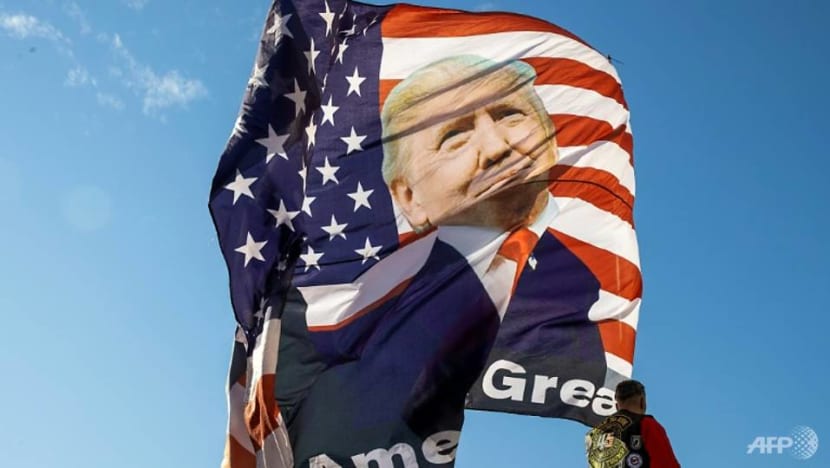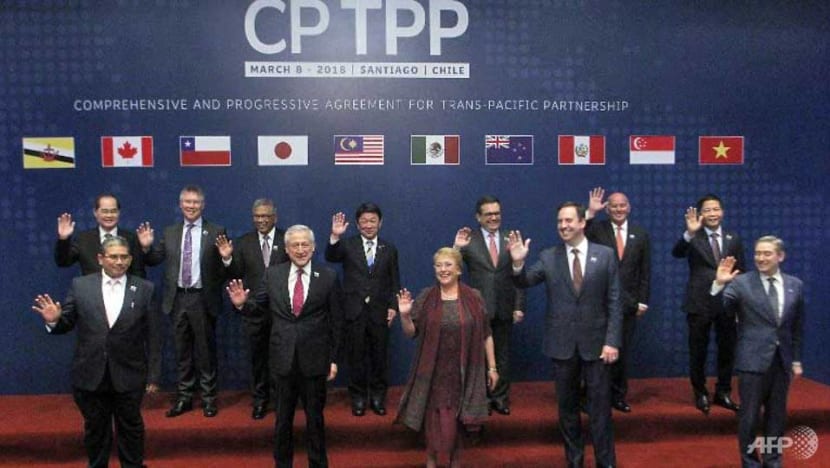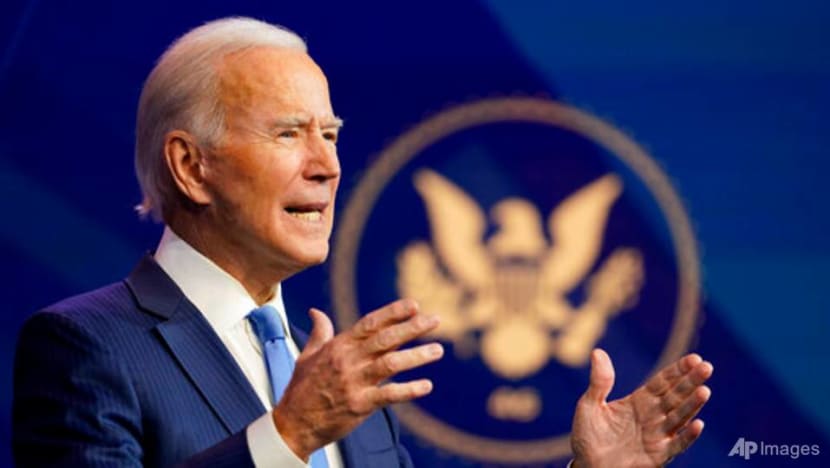commentary Commentary
Commentary: US paid dearly for absence in Pacific trade deal
The opportunity costs in terms of incomes and jobs make joining the Comprehensive Partnership for Trans-Pacific Partnership a top priority for the US when Joe Biden takes over, say Carlos Kuriyama and Dr Cai Daolu.

A protest in Washington on December 12, 2020 drew several thousand supporters of President Donald Trump; many insisted without evidence that he defeated Democrat Joe Biden in the November election. (Photo: AFP/TASOS KATOPODIS)
SINGAPORE: When Donald Trump’s administration withdrew the United States from the Trans-Pacific Partnership (TPP) in 2017, giving teeth to the new “America First” policy, observers sat up.
Under former President Barack Obama, the US had sought to pursue deeper regional integration in the Asia-Pacific through greater investments, business links and more, enabled through this ambitious free trade agreement.
Although Obama could not pass the TPP through Congress, it was Trump’s subsequent withdrawal, coupled with his electoral promises emphasising an agenda of restoring American primacy, that stoked concerns over isolationism and disengagement from the Asia-Pacific.
The decision by Trump has had a huge economic cost, both for the US and the rest of the world, proving not only how the rhetoric of isolationism has been economically counter-productive but also inimical to Americans’ interests.
READ: Commentary: Trump’s playbook on China in the South China Sea has some lessons for the Biden administration
POTENTIAL INCOME LOST
Recent estimates suggest the TPP would have increased annual real incomes in the US by US$131 billion in 10 years.
Similar benefits are also substantial for the world, where the gains in global GDP would have been US$492 billion dollars.
In contrast, the implementation of the Comprehensive and Progressive Trans-Pacific Partnership (CPTPP), by the rest of the TPP parties, is estimated to cost the US US$2 billion in real income losses by the same year.
The Asia-Pacific is critical to the US for security and economic reasons. The US’ presence has helped to bring stability in the region for decades by establishing a strategic balance among the different parties involved.

This peaceful environment has been a key pillar underwriting the region’s economic growth and rapid development.
From an economic standpoint, the US too has benefited from its greater strategic position there. Several US companies from a wide range of sectors do business in the Asia-Pacific and maintain a significant presence.
In terms of goods, nearly 40 per cent of US imports originate from this region, and around 25 per cent of the US exports are destined for this market.
That trend may accelerate as the world digitalises. Tech titans like Google have taken a shine to the burgeoning start-up space with investments of up to US$350 million in Indonesian e-commerce giant Tokopedia.
READ: Commentary: Multibillion-dollar wizards – how COVID-19 is exposing what’s behind the curtain
Walmart has acquired a 7.5 per cent stake in TikTok to further its ambitions in video commerce, giving it an advantage over Amazon.
THE WINDS OF CHANGE
The results of the US elections last November suggest the US trade strategy in the Asia-Pacific could change. The optimistic view is a change in trade policy will follow.
After all, President-elect Joe Biden was a supporter of the TPP during the Obama administration. He has an expressed preference to pursue multilateral and regional engagement instead of the unorthodox approach Donald Trump has embraced.

This would be to the region’s advantage. Deepening regional economic integration with the Asia-Pacific would strengthen strategic partnerships and strengthen regional stability.
As open and connected global supply chains become increasingly crucial to countries grappling with the effects of closed borders and restrictions on movements arising from COVID-19 and the US-China trade war this year, trade pacts like the CPTPP could provide some buffer against such uncertainty and ensure some level of diversification.
It would also be to the US’s advantage to join the CPTPP and improve its competitiveness, where the lowering of trade barriers, increased market access and imposed higher standards would spur investments, boost exports and bolster productivity.
READ: Commentary: Thanks to China's move on Ant, FinTech firms may look like banks soon
READ: Commentary: How Tencent became world’s most valuable social media company – and then everything changed
This is the most dynamic region in the world. Increased trade could create more opportunities for US services providers and offer better market access terms to American products.
Re-engaging with the Asia-Pacific has an added significance now for the US, given the signing of the Regional Comprehensive Economic Partnership (RCEP) between ASEAN member countries, Australia, China, Japan, South Korea and New Zealand a few weeks ago is creating the largest world’s free trade area, accounting for around 30 per cent of the global GDP and population.
The RCEP could reduce economic opportunities for the US in the Asia-Pacific region by diverting trade and investment flows and consolidating value chains across in favour of RCEP parties.

READ: Commentary: RCEP a huge victory in tough times
A CLOSING WINDOW
However, the re-engagement process will not be easy for the US. To put in force the TPP or seek to join CPTPP, President-elect Biden needs to get a Trade Promotion Authority (TPA) from the Congress, which provides the authority to the executive branch to negotiate free trade agreements and implement it in an expedited manner.
The current TPA expires on July 1, 2021. This may be too short a time from Biden’s inauguration and there is no legislative proposal yet to issue a new one. Most actions in Congress will likely focus on dealing with the COVID-19 pandemic and its economic impact.
Furthermore, any TPA extension or ratification of a free trade agreement will require approval by the US Congress. This is a difficult process.
The Biden administration will only have the majority in the House of Representatives, where some Democratic representatives have historically been averse to free trade agreements. Two seats (in Georgia) are yet to be decided in January to determine control of the Senate after a six-year Republican majority.
In addition, the Republican-controlled Senate may not support these initiatives, as was the case in 2016, when the Obama administration calculated there were not enough votes to get the TPP through before the end of his term.
READ: Commentary: Is it too late for the US to join the CPTPP?
READ: Commentary: Looks like China has its own '+1' strategy and Southeast Asia is it
Joining the CPTPP may also require substantial negotiation. When the CPTPP was agreed, the parties incorporated most of the TPP clauses, but suspended the application of certain clauses, mostly related to services, investment and intellectual property, which had been proposed by the US, but were sensitive to other TPP parties.
We would not rule out other countries being open to the US signing on, without these unpopular clauses, though it is likely that CPTPP parties will have to go through their own domestic procedures to approve any accession of a new member or a renegotiation of the CPTPP agreement.
JOINING CPTPP SHOULD BE ON THE CARDS
A negotiation of the US’s entry into the CPTPP should be on the cards for the incoming Biden administration.
President-elect Biden needs to find the right formula to get enough bipartisan support to pass a new deal.

Perhaps, stronger labour and environmental chapters, together with more comprehensive provisions on trade facilitation, digital trade and financial services, could support this initiative.
This formula may be effective considering the work done in the past to pass the United States-Mexico-Canada trade agreement (USMCA). Adding to that, President-elect Biden’s pick to be the US Trade Representative, Katherine Tai, played a decisive role getting bipartisan support to pass this agreement.
Carlos Kuriyama is Senior Analyst at the Asia-Pacific Economic Cooperation (APEC) Secretariat’s Policy Support Unit.
Dr Cai Daolu is visiting senior fellow at the NUS Business School’s Department of Strategy and Policy.
The views expressed in this article are those of the authors and do not represent those of the APEC Secretariat nor NUS.
















